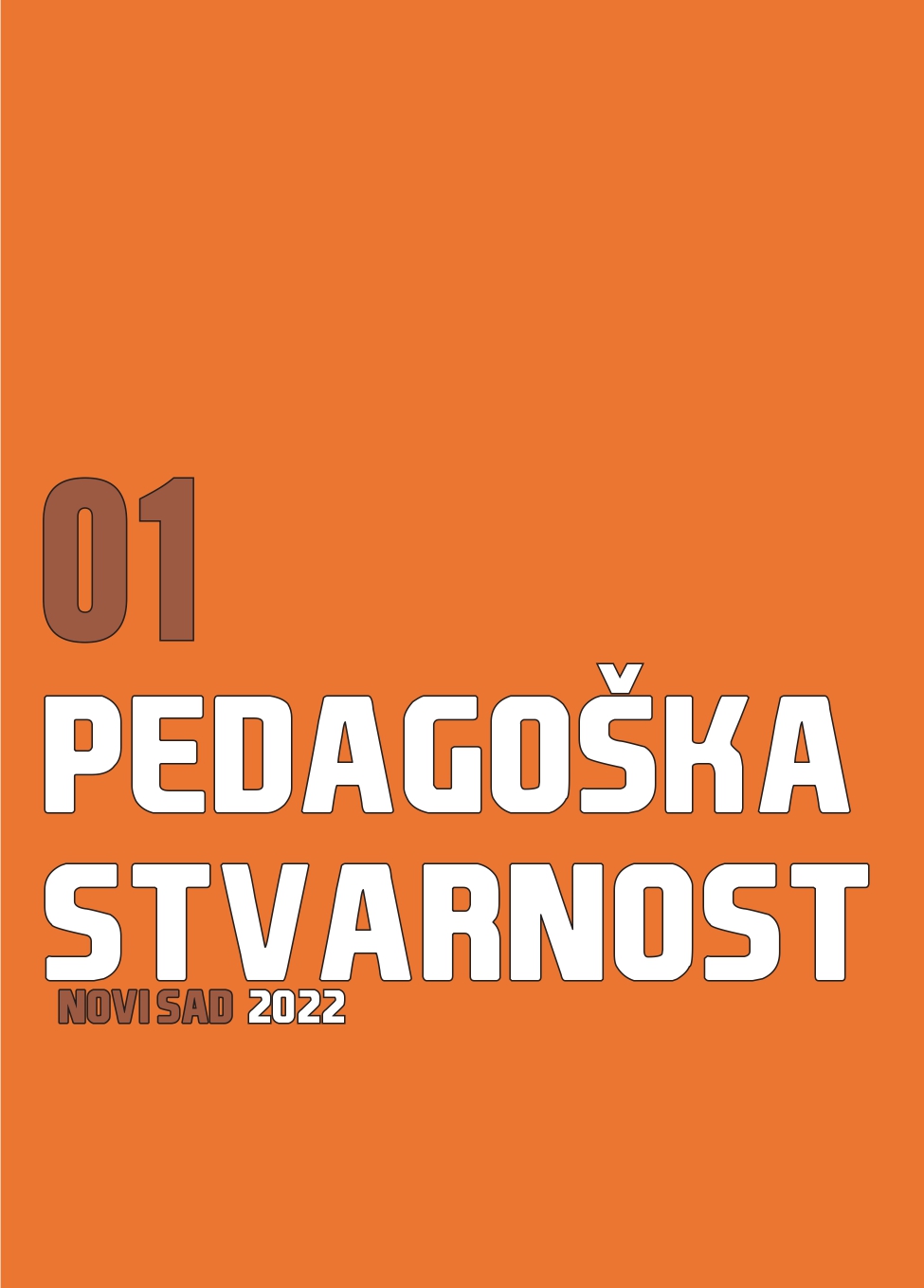DIGITALNO RODNO ZASNOVANO NASILJE U EMOTIVNIM VEZAMA UČENIKA IZ PERSPEKTIVE NASTAVNIKA I STRUČNIH SARADNIKA U SREDNJOJ ŠKOLI
Originalni naučni rad
Apstrakt
Predmet istraživanja je to kako nastavnici i stručni saradnici u srednjoj školi sagledavaju digitalno rodno zasnovano nasilje u emotivnim vezama svojih učenika i kako vide svoje kompetencije i ulogu škole. Cilj istraživanja je prikupljanje i analiza stavova, iskustava, znanja i potreba nastavnika i drugog školskog osoblja u vezi sa navedenom pojavom, koja do sada nije istraživana u našem kontekstu. U istraživanju eksplorativnog tipa, kvantitativne prirode, korišćen je strukturirani upitnik, kreiran za ovu priliku. Prigodni uzorak od 209 predstavnika iz devet srednjih škola u pet gradova u Srbiji, ne omogućava generalizaciju zaključaka, ali upućuje na moguće pravce delovanja i potrebu daljih istraživanja. Rezultati ukazuju na umereno prisustvo rodnih stereotipa, više prisutno kod ispitanika iz stručnih škola i muškog pola. Većina ispitanika ne zna da li je reč o ozbiljnom problemu i nikada nije dobila informaciju o konkretnom slučaju. Oni koji imaju saznanje o ovakvim slučajevima izveštavaju o velikim razlikama u iskustvima devojaka i mladića kada je reč o svim specifičnim oblicima digitalnog rodno zasnovanog nasilja, kojem su češće i sa većim štetnim efektima izložene devojke. Skoro svaki peti ispitanik ističe slaba znanja o ovom problemu, a većina nije uključena u preventivne aktivnosti. Prema njihovom mišljenju intervencije treba da su sistemske prirode, usmerene na veći broj aktera unutar i izvan škole.
Reference
Bogavac, Lj., Otašević, S., Cucić, V. i Popadić, D. (2015). Prva nacionalna studija o društvenom problemu seksualnog zlostavljanja dece u Republici Srbiji. Beograd: Incest trauma centar. Preuzeto septembar, 10, 2020 sa https://bit.ly/2za- QGVM
Carmody, M., (2009). Conceptualizing the prevention of sexual assault and the role of education. The Australian Centre for the Study of Sexual Assault, Australian Institute of Family Studies, Melbourne: Australia.
Carmody, M., Evans, S., Krogh, C., Flood, M., Heenan, M., & Ovenden, G. (2009). Framing best practice: National Standards for the primary prevention of sexual assault through education. National Sexual Assault Prevention Education Project for NASASV. University of Western Sydney, Australia.
Cascardi, M., King, C. M., Rector, D., & DelPozzo, J. (2018). School-Based Bullying and Teen Dating Violence Prevention Laws: Overlapping or Distinct? Journal of Interpersonal Violence, 33(21), 3267–3297. https://doi. org/10.1177/0886260518798357 J
Ćeriman, J., Duhaček, N., Perišić, K., Bogdanović, M. i Duhaček, D. (2015). Istraživanje rodno zasnovanog nasilja u školama u Srbiji. Beograd: Centar za studije roda i politike, Fakultet političkih nauka, Univerzitet u Beograd i UNICEF. Pre- uzeto februar, 10, 2022 sa https://bit.ly/3cYhxTb
Chatzakou, D., Leontiadis, I., Blackburn, J., De Cristofaro, E., Stringhini, G., Vakali, A., & Kourtellis, N. (2019). Detecting Cyberbullying and Cyberaggression in Social Media. ACM Transactions on the Web, 13(3), 1-51. DOI: 10.1145/3343484
Crismaa, M., Bascellia, E., Pacib, D., & Romito, P. (2004). Adolescents who experienced sexual abuse: fears, needs and impediments to disclosure. Child Abuse & Neglect, 28(10), 1035–1048. DOI: 10.1016/j.chiabu.2004.03.015.
Crooks, C. V., Jaffe, P., Dunlop, C., Kerry, A., and Exner-Cortens, D. (2019). Preven- ting Gender-Based Violence Among Adolescents and Young Adults: Lessons From 25 Years of Program Development and Evaluation. Violence Against Women, 25(1), 29-55. DOI: 10.1177/1077801218815778
Đan, A., i Jovanović, N. (2011). Prepoznaj nasilje u partnerskim odnosima – Vodič za mlade. Novi Sad/Beograd: Pokrajinski Sekretarijat za rad, zapošljavanje i ravnopravnost polova i Autonomni ženski centar. Preuzeto Februar , 10, 2022 sa https://bit.ly/3f2LrHR
European Institute for Gender Equality (EIGE). (2017). Cyber violence against women and girls. Preuzeto Februar , 10, 2022 sa https://eige.europa.eu/publications/ cyber-violence-against-women-and-girls
European Union Agency for Fundamental Rights (FRA). (2014). Violence against women: an EU-wide survey - Main results. Preuzeto retrieved February, 10, 2022 sa https://fra.europa.eu/en/publication/2014/violence-against-women-eu-wi- de-survey-main-results-report
European Women’s Lobby - Observatory on violence against women (EWL). (2017). #HerNetHerRights – Mapping the state of online violence against women & girls in Europe. Brussels: European Women’s Lobby. Preuzeto Februar, 10, 2022 sa https://bit.ly/3eYbYpv
Frison, E., & Eggermont, S. (2015). Exploring the relationships between different types of Facebook use, perceived online social support and adolescents’ depressed mood. Social Science Computer Review, 34(2): 153–171. https://doi. org/10.1177/0894439314567449
Frison, E., Subrahmanyam, K., & Eggermont, S. (2016). The Short-Term Longitudinal and Reciprocal Relationships between Peer Victimization on Facebook and Adolescents’ Well-Being. Journal of Youth and Adolescence, 45(9), 1755–1771. https://doi.org/10.1007/s10964-016-0436-z
Grujić, S. (ur.) (2015). Priručnik za prevenciju rodno zasnovanog nasilja. Beograd: Ministarstvo prosvete, nauke i tehnološkog razvoja Republike Srbije i UNICEF. Preuzeto februar, 10, 2022 sa https://bit.ly/2y8tdnz
Haselschwerdt, M. L., Carlson, C. E., & Hlavaty, K. (2018). The Romantic Relationship Experiences of Young Adult Women Exposed to Domestic Violence. Journal of Interpersonal Violence, 1;886260518771679. DOI: 10.1177/0886260518771679.
Henry, N. & Powell, A. (2014). The Dark Side of the Virtual World - Towards a Digital Sexual Ethic. In: N. Henry & A. Powell (Eds), Preventing Sexual Violence: Interdisciplinary Approaches to Overcoming a Rape Culture, 84-104. Basing- stoke, UK and New York, US: Palgrave Macmillan.
Ignjatović, T. (Ur.) (2018). Zašto i kako o temi rodno zasnovanog nasilja u školskom programu u srednjim školama? Beograd: Autonomni ženski centar. Preuzeto Septembar, 10, 2020 sa https://bit.ly/2yUB7kk
Ignjatović, T., Ileš, M. (Ur.) (2018). Odgovor obrazovno-vaspitnih institucija na rodno zasnovano nasilje i nasilje u porodici – Zbirka stručnih tekstova. Beograd: Autonomni ženski centar. Preuzeto februar, 10, 2022 sa https://bit.ly/2Yg8NDV
Ignjatović, T., Ileš, M., Delibašić, A. (ur.) (2018). Nulta tolerancija na rodno zasno- vano nasilje – Priručnik za uključivanje tema rodne ravnopravnosti i rodno zasnovanog nasilja u nastavu i vaspitne aktivnosti srednjih škola. Beograd: Autonomni ženski centar. Preuzeto februar, 10, 2022 sa https://bit.ly/2KO8aJv
Ignjatović, T., Ileš, M. (ur.) (2021). Prevencija i odgovor na (digitalno) seksualno i rodno zasnovano nasilje - priručnik za nastavnike. Beograd: Autonomni ženski centar. Preuzeto februar, 10, 2022 sa https://bit.ly/3u7xZuz
Kalaitzaki, A., (2020). Cyberstalking Victimization and Perpetration Among Young Adults: Prevalence and Correlates. In: M. F. Wright (Ed.) Recent Advances in Digital Media Impacts on Identity, Sexuality, and Relationships (pp. 22-38). USA: IGI Global. DOI: 10.4018/978-1-7998-1063-6.ch002
Kamal, M., & Newman, W. J. (2016). Revenge Pornography: Mental Health Implications and Related Legislation. The Journal of the American Academy of Psychiatry and the Law, 44(3), 359 – 367.
Kuzmanović, D., Lajović, B., Grujić, S. i Medenica, G. (2016). Digitalno nasilje – pre- vencija i reagovanje. Beograd: Ministarstvo prosvete, nauke i tehnološkog ra- zvoja Republike Srbije i Pedagoško društvo Srbije. Preuzeto, februar, 10, 2022 sa https://www.unicef.org/serbia/media/5771/file/Digitalno%20nasilje.pdf
Kuzmanović, D., Pavlović, Z., Popadić, D. i Milošević, T. (2019). Korišćenje interneta i digitalne tehnologije kod dece i mladih u Srbiji: rezultati istraživanja Deca Evrope na internetu. Beograd: Institut za psihologiju Filozofskog fakulteta u Beogradu. Preuzeto februar, 10, 2022 sa https://bit.ly/35dbzLs
Kuzmanović, D., Zlatarović, V., Anđelković, N., i Žunić-Cicvarić, J. (2019). Deca u digitalnom dobu - Vodič za bezbedno i konstruktivno korišćenje digitalne teh- nologije i interneta. Užice: Užički centar za prava deteta. Preuzeto februar , 10, 2020 sa https://uni.cf/2yUBjA4
Lemaigrea, C., Taylorb, E. P., & Gittoesc, C. (2017). Barriers and facilitators to disc- losing sexual abuse in childhood and adolescence: A systematic review. Child Abuse & Neglect, 70, 39-52. DOI: 10.1016/j.chiabu.2017.05.009
Livazović, G., & Ham, E. (2019). Cyberbullying and emotional distress in adolescents: the importance of family, peers and school. Heliyon, 5(6), e01992. DOI: 10.1016/j.heliyon.2019.e01992
Marín Cortés, A. F., De los Ríos, O. L., & Sierra Pérez, A. (2019). Risk and protective factors related to cyberbullying among adolescents: a systematic review, Papeles del Psicólogo / Psychologist Papers, 40(2), 109-124. https://doi. org/10.23923/pap.psicol2019.2899
Marín-López, I., Zych, I., Ortega-Ruiz, R., Hunter, S. C. & Llorent, V. J. (2019). Relations among online emotional content use, social and emotional competencies and cyberbullying. Children and Youth Services Review, 108, 104647. https:// doi.org/10.1016/j.childyouth.2019.104647
Monks, C. P., & Van Zalk, N. (2020). Adolescent Relationships in a Digital Age: What Do We Know and Where Does the Future Lie? In: N. Van Zalk, & C. Monks (Eds.) Online Peer Engagement in Adolescence: Positive and Negative Aspects of Online Social Interaction. London: Routledge.
Muñoz-Fernández, N., Ortega-Rivera, J., Nocentini, A., Menesini, E., & Sánchez-Ji- ménez, V. (2019). The Efficacy of the “Date Adolescence” Prevention Program in the Reduction of Dating Violence and Bullying. International Journal of Environmental Research and Public Health, 16(3), 408. DOI:10.3390/ ijerph16030408
Nasaescu, E., Marín-López, I., Llorent, V. J., Ortega-Ruiz, R., & Zych, I. (2018). Abuse of technology in adolescence and its relation to social and emotional competencies, emotions in online communication, and bullying. Computers in Human Behavior, 88, 114-120. DOI: 10.1016/j.chb.2018.06.036
Okumu, M., Kim, Y. K., Sanders, J. E., Makubuya, T., Small, E., & Hong, J. S. (2020). Gender-Specific Pathways between Face-to-Face and Cyber Bullying Victimization, Depressive Symptoms, and Academic Performance among U.S. Adolescents. Child Indicators Research. https://doi.org/10.1007/s12187-020-09742-8
Olumide, A. O., Adebayo, E., Oluwagbayela, B. (2016). Gender disparities in the experience, effects and reporting of electronic aggression among secondary school students in Nigeria. British Medical Journal Global Health 1(3), e000072. DOI:10.1136/ bmjgh-2016-000072
Oriol, X., Miranda, R., & Amutio, A. (2019). Correlates of Bullying Victimization and Sexual Harassment: Implications for Life Satisfaction in Late Adolescents. The Journal of School Nursing. https://doi.org/10.1177/1059840519863845
Pavlović, S. (2020). Svest, iskustva i strategije srednjoškolki i srednjoškolaca za imenovanje problema digitalnog seksualnog i rodno zasnovanog nasilja - izveštaj za Srbiju. Beograd: Autonomni ženski centar. Preuzeto Februar, 10, 2022 sa https://bit.ly/37s7LLs
Perren, S., Corcoran, L., Cowie, H., Dehue, F., Garcia, D’J., Mc Guckin, C., Sevcikova, A., Tsatsou, P., Völlink, T. (2012). Tackling Cyberbullying: Review of Empirical Evidence Regarding Successful Responses by Students, Parents, and Schools. International Journal of Conflict and Violence, 6(2), 283 – 293. DOI:10.4119/ijcv-2919
Popadić, D. i Kuzmanović, D. (2013). Korišćenje digitalne tehnologije, rizici i zastupljenost digitalnog nasilja među učenicima u Srbiji. Beograd: Institut za psihologiju Filozofskog fakulteta Univerziteta u Beogradu. Preuzeto Februar, 10, 2022 sa https://www.unicef.org/serbia/publikacije/digitalno-nasilje-u-srbiji
Smahel, D., Machackova, H., Mascheroni, G., Dedkova, L., Staksrud, E., Ólafsson, K., Livingstone, S., & Hasebrink, U. (2020). EU Kids Online 2020: Survey results from 19 countries. EU Kids Online. DOI: 10.21953/lse.47fdeqj01ofo
Sorrentino, A., Baldry, A. C., Farrington, D. P., & Blaya, C. (2019). Epidemiology of Cyberbullying across Europe: Differences between Countries and Genders. Educational Sciences: Theory & Practice, 19(2), 74-91. http://dx.doi. org/10.12738/estp.2019.2.005
Tokunaga, R. S. (2010). Following you home from school: A critical review and synt- hesis of research on cyberbullying victimization. Computers in Human Behavior 26(3), 277–287. DOI: 10.1016/j.chb.2009.11.014
Vranješević, J., Maksimović, B., Lajović, B., Nikolić, J., Bunčić, M., Čukuranović, G., Trkulja, M., Grujić, S., Kraguljac, N., Radulović, V., Jović, Z. (2020). Ka sigur- nom i podsticajnom školskom okruženju – Vodič za škole, Beograd: Ministarstvo prosvete, nauke i tehnološkog razvoja Republike Srbije. Preuzeto Februar ,10, 2022 sa https://uni.cf/3aLcqEj
Vuksanović, N. (2019). Karakteristike nastavnog osoblja u obrazovnom sistemu Srbije: Analiza zarada, rodne zastupljenosti i starosti nastavnika po obrazovnim nivoima. U D. Malidžan Vinkić (Ur.) Program za kreiranje obrazovnih politika na osnovu podataka i rezulatata istraživanja. Beograd: Tim za socijalni uključivanje i smanjenje siromaštva Vlade Republike Stbije. Preuzeto Februar, 10, 2022 sa https://bit.ly/2YCWami
Wright, M. F., & Wachs, S. (2019). Adolescents’ Psychological Consequences and Cyber Victimization: The Moderation of School-Belongingness and Ethnicity. International Journal of Environmental Research and Public Health, 16(14), 2493. DOI:10.3390/ijerph16142493
Zych, I., Viejo, C., Vila, E., & Farrington, D. P. (2019). School Bullying and Dating Violence in Adolescents: A Systematic Review and Meta-Analysis. Trauma, Violence, & Abuse, 11;1524838019854460. DOI: 10.1177/1524838019854460.








